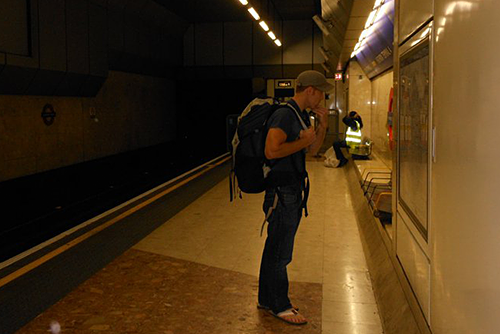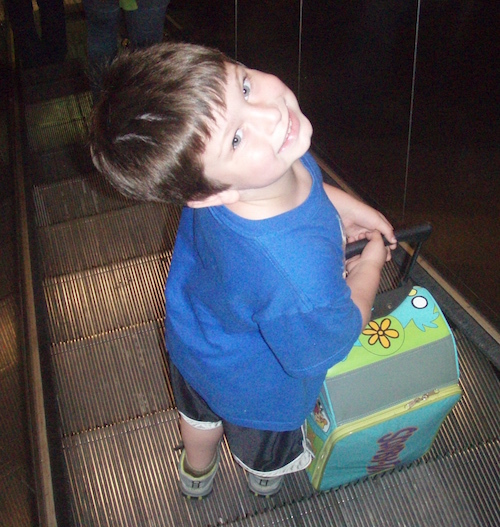Rolf Potts's Blog, page 16
February 6, 2015
Lost in Transaction
 One of the most startling travel epiphanies I’ve had in recent years came on a trip to Burma, when I was counting out small change so I could buy a packet of toilet tissues. The Burmese kyat had recently suffered a jag of devaluation, and when I’d tallied up my toilet-tissue money, I noticed that it consisted of twelve small denomination bills.
One of the most startling travel epiphanies I’ve had in recent years came on a trip to Burma, when I was counting out small change so I could buy a packet of toilet tissues. The Burmese kyat had recently suffered a jag of devaluation, and when I’d tallied up my toilet-tissue money, I noticed that it consisted of twelve small denomination bills.
Given that Burmese tissues came in packets of ten, it occurred to me that it would be more economical to just wipe my ass in kyat and pocket the difference.
Though this Burma experience was an unusually vivid example, travel always has a way of testing one’s faith when it comes to the workings of money. At home, one can pass bills without thinking too much about it, but the arbitrariness of modern currency can be alarmingly apparent when one is abroad.
As a veteran Asia traveler, my bewilderment with legal tender goes back to a day seven years ago, when an elderly vendor in Phnom Penh’s Russian Market refused to accept a worn $10 bill I’d brought directly from the United States. “Too old,” she’d told me. When I asked the woman to show me an example of acceptable currency, she held up a discolored (yet crisp) $20 bill that had obviously been counterfeited locally. In Cambodia, it seemed, the true value of American money was not pegged to its authenticity, but to whether or not it was wrinkled.
Such an idiosyncrasy may well derive from fact that portable currency (a system created in part by the demands of travel itself) has never been foolproof. In areas where a standardized money system has yet to catch on, for example, the act of shopping can prove ambiguous. In the 19th century guidebook The Art of Travel, Francis Galton suggested bringing beads and shells to use as “small change” when traveling in remote regions. Galton warned against knickknack-inflation, however — noting that one African chief had complained that his women were already “grunting like pigs” under the burden of beads given to them by previous travelers.
Other times, the absence of standardized currency has worked in travelers’ favor. Pioneering voyages to the South Pacific abound with tales of an improvised iron-based economy, wherein a sailor could acquire a short-term Tahitian wife through the gift of “an old razor, a pair of scissors, or a very large nail.” In 1767, Captain Samuel Wallis of the Dolphis had to forbid his men from trading nails for anything save wood or water, “to preserve the ship from being pulled to pieces” by horny sailors. Of course, iron isn’t the only item that has served as de facto travel currency. Wandering Norsemen once brokered deals in butter, the nomads of the Sahara traded in salt, and (in a scenario that’s fun to imagine) ancient Aztecs paid off their debts in chocolate. Tobacco was legal tender along the roads of colonial Virginia — a fact that sounds strange only until you consider that cigarettes were used as money in many parts of Europe after World War II.
In fact, paper money — which carries a purely hypothetical value — has only recently caught on as a world currency. The Chinese may have valued paper notes against silk to mixed success 1000 years ago, but a similar effort in 13th century Persia was ruined by counterfeiters. William the Bad tried to introduce leather money in 14th century Sicily — though (given the king’s unfortunate name) it’s easy to conclude that this royal experiment didn’t go over so well. To this day, the uncertainty of paper money has been known to break a regime: In late 2001, forged paper notes reportedly helped destabilize the Taliban government (one naturally wonders what graven image the Afghan Islamists had printed on their money — a grenade? an unplugged TV set? a smashed chunk of Buddha statue?).
Even in the United States, a paper dollar has little inherent value beyond the fact that it’s a part of the largest system of common faith in the world. Indeed, despite doctrinal differences, Buddhists, Christians, Muslims, Jews, Hindus and animists readily accept paper dollars — and even the metaphysical workings of the dollar’s “managed system” of value (wherein American banks and the Federal Reserve determine, Old Testament-style, that a dollar Is What It Is) seems firmly rooted in the ways of shared belief.
When such faith begins to crumble, of course — like it did for me in Burma — it’s easy to conclude that, for all its usefulness, paper money is still just paper.
For the record, I went ahead and swapped those twelve banknotes for ten tissues. But only because the latter were more absorbent.
[This Rolf Potts article originally appeared in Yahoo! News on March 27, 2006. All rights reserved.]
Original article can be found here: Lost in Transaction
February 5, 2015
Vagabonding Case Study: Jessica Festa
jessieonajourney.com and epicureandculture.com 
Age: 27
Hometown: Farmingville, New York on Long Island
Quote: You may say I’m a dreamer, But I’m not the only one, I hope someday you will join us, And the world will be as one – John Lennon (Imagine)
How did you find out about Vagabonding, and how did you find it useful before and during the trip?
Vagabonding was one of the first travel blogs I ever came across, probably about four years ago when I was embarking on my own journey into blogging with Jessie on a Journey and Epicure & Culture. I found it useful not just for travel, but also for improving my writing and getting inspired, especially with the “Stories and Reportage.”
How long were you on the road?
I also checked out some of the South America-related Vagablogging Field Reports before a four-month backpacking trip through South America (and Mexico and Colorado on the way back). I enjoyed it because it added insight that went further than the typical list guide posts.
Where did you go?
I started the trip in Brazil and made my way through Argentina, Bolivia, Peru, Ecuador and the Galapagos, doing lots of hiking and cycling along the way. I loved being able to explore such beautiful landscapes and diverse destinations by bus and on a budget. I actually wrote a post on Jessie on a Journey titled, “Why South America is the Best Destination for Backpackers.”
I’m actually very excited, as I’m returning to South America — specifically Colombia — on Tuesday for a few weeks of hiking, camping, dance classes and lots of food!
What was your job or source of travel funding for this journey?
During this trip I was already travel blogging, so my websites, freelance stories and photography were how I funded this trip. Before blogging I was a waitress and restaurant manager for almost five years, so I also had money saved from that part of my life.
Did you work or volunteer on the road?
I have. In terms of volunteering, the experiences I took part in — teaching English during a summer in Thailand and working at an orphanage for a summer in Ghana, both over four years ago — I found extremely rewarding and felt like I was making a difference.
That being said, the more I delve into the world of responsible tourism — Epicure & Culture focuses on ethical travel and I’m also the founder of Responsible Tourism Twitter Chat (#RTTC) — the more I realize the experiences weren’t as responsible as I would have liked them to be. I was essentially thrown into projects without being asked about my skills, and I didn’t ask the proper questions beforehand to figure out how I would be impacting the community.
Orphanage tourism especially is tricky, as the constant stream of voluntourists coming in and out of the children’s lives can have negative consequences on their mental health. I know our volunteer group in Ghana did some good, though — we built a chicken coop and bought chickens so the kids would get some protein in their diet, and the ones over 18 could sell some in the markets. We also showed them how to care for the animals so they could take over the project once we set it up.
If I could do it again, though, I would definitely do a lot more research into the impacts of the project and the ethics of the organization I’m working with. On Epicure & Culture we have an article titled “Common Volunteer Mistakes and How to Fix Them” that delves into all this.
As for working, I was employed at a pizza place in Australia answering phones and cooking, while also taking part in an internship that had me crafting neighborhood guides around Sydney for study abroad students. Both jobs were great!
Of all the places you visited, which was your favorite?
Oh! That’s really difficult to answer. It really depends on where I’ve just been as well as what type of travel I’m in the mood for. There are a few places that stick out in my mind: the Kansai Region in Japan for the variety of cultural experiences and the delicious food; Patagonia for the otherworldly trekking landscapes and adventure opportunities; Kerala due to the nature of the trip, cycling and staying on organic farms; and Jordan for the mix of history and culture. In Jordan, hiking through the Dana Biosphere Reserve to Feynan and being invited into Bedouin tents for goat’s milk along the way was really special!
Was there a place that was your least favorite, or most disappointing, or most challenging?
I sort of have a love/hate relationship with Ghana, Africa. I lived with a family so it was great being immersed in the culture; however, we had no running water or plumbing, barely any electric and were eating a lot of rice water, so it was definitely a challenge going from a comfortable New York lifestyle to that — although it definitely made me appreciate what I had, and showed me just how adaptable people really are.
I also found it challenging to have the locals all shouting “oberoni!” (foreigner!) at me literally every two seconds, which I was told by my homestay mom meant they wanted to talk. To me, it felt like they were yelling or making fun of me. That took a lot of getting used to.
Which travel gear proved most useful? Least useful?
I’m a big fan of pickpocket-proof clothing from companies like Clever Travel Companion or Clothing Arts, where there are hidden inside pockets so thieves don’t even know you have valuables. I also never go anywhere without a long sleeve Smartwool shirt to keep dry when hiking, and I love my GoPro and Nokia Lumia Icon which both allow me to get great video/photo footage and don’t take up a lot of space in my backpack. That being said, I try to keep tech gear to a minimum when traveling, although I need to bring a few items to blog on the road. To me, it’s when important to be present when traveling, and often our gadgets can be an unnecessary distraction from what’s around us.
What are the rewards of the vagabonding lifestyle?
Extreme growth. I’ve learned more on the road than college could have ever taught me (although I did go to college, too, and actually have a Master’s Degree). I’ve become more humble, immersed myself in other cultures, learned new ways of viewing issues, and have seen the world beyond words in a textbook. I’m incredibly thankful for being able to travel and have so many adventures at such a young age. I’ve especially learned a lot traveling solo as a female, especially about myself.
What are the challenges and sacrifices of the vagabonding lifestyle?
The main challenge for me is missing out on important events in loved ones’ lives: birthdays, weddings, births, graduations. Moreover, the past year I’ve been in a serious relationship that has also at times been difficult, wanting to be here in New York with my boyfriend but also desperately wanting to move to Guatemala for a while or head to Indonesia to backpack for six months. There are a lot more compromise to my itineraries now.
What lessons did you learn on the road?
The biggest lesson I’ve learned is that anything is possible. When I graduated with my BA/MA in Communication there weren’t really any jobs available in my field. So I made my own through travel blogging. Now I work for myself and can see the world. Anything is possible.
How did your personal definition of “vagabonding” develop over the course of the trip?
The definition itself didn’t really change for me. What changed was having it go from being a word I’d heard, to a word I was living. That was an amazing feeling.
If there was one thing you could have told yourself before the trip, what would it be?
You’ll figure it out. Before that particular trip I was particularly nervous as I was traveling solo as a female through all these countries that people were telling me were dangerous. Despite the fact I knew other bloggers who had traveled through South America without issue, I still was nervous about being robbed, losing my passport, my Spanish not being perfect, getting lost. The truth is, when presented with a problem you’ll figure out the answer. This is especially rewarding when you’re traveling solo, as you really learn how much you’re capable of.
Any advice or tips for someone hoping to embark on a similar adventure?
Pack light! The more you bring, the more you have to worry about (and the more your back will hurt!). The lighter your bag, the lighter your worries. Also, leave those valuables at home. Hopefully this doesn’t happen, but if you do lose your bag/it gets stolen, you’ll want it to be filled with easily-replaceable items, not your grandmother’s jewelry or your $2,000 laptop.
When and where do you think you’ll take your next long-term journey?
As mentioned above, I’m going to Colombia on Tuesday for a few weeks. I’m also hoping to rent an apartment in Guatemala for a few months next year. My boyfriend and I went to Guatemala in the beginning of this year and both absolutely loved every moment of our trip, from volcano hikes to exploring Lake Atitlan to sleeping in a treehouse outside of Antigua. It was fantastic.
Read more about Jessica on her blog, Jessie On A Journey & Epicure and Culture , or follow her on Facebook and Twitter.
Website: Jessie On A Journey & Epicure and Culture
Twitter: @JessonaJourney
Are you a Vagabonding reader planning, in the middle of, or returning from a journey? Would you like your travel blog or website to be featured on Vagabonding Case Studies? If so, drop us a line at casestudies@vagabonding.net and tell us a little about yourself.
Original article can be found here: Vagabonding Case Study: Jessica Festa
February 4, 2015
Trip Report: how we did Oman for $570 in airfare and accommodations for two
When I first became interested in traveling, airfare and accommodations were the two most daunting expenses. Both such expenses can add up quite quickly. For example, these days $420 may not seem like enough to pay for airfare and accommodations for two people visiting the Middle East. But when you are willing to combine a few “travel-hacking” strategies to make it happen, it’s absolutely possible to do a trip like this.
Perhaps the best way to tell you how is simply to lay out the exact costs my husband and I had for airfare and accommodations for our recent trip to Oman.
Now, I’m not assuming that Oman is a particularly popular travel destination. It’s simply an example of a recent trip for which we utilized enough of our travel-hacking strategies to keep the travel-related costs below $500. With a bit of adaptation, you could apply these strategies to a variety of travel destinations.
Trip Details:
We flew from DC to Oman (with a layover in Amsterdam) in economy class and returned from Oman on the same route a week later. Excluding nights spent on the plane in transit, we spent 6 nights in Oman.
Firstly, let’s tackle the issue of airfare:
Expense: $420 roundtrip for 2 people
(You may notice that this now accounts for the entire “airfare and accommodations” costs. I’ll explain that in a bit…)
Strategy: Mistake Fares
Mistake fares are not the kind of flight deals you can count on if you have a very specific destination in mind. But if you are the kind of person who is curious about a variety of destinations, mistake fares are great.
Just as their name implies, these are simply airfare prices that have come about because of some kind of error in how the price was programmed. These rates disappear as soon as the booking sites who’ve made the errors recognize and fix them, so you have to make your decision about booking quickly. To learn more about how to find these accidental sales, see this post about how to find mistake fares.
Now let’s take a look at how we covered 6 nights of accommodations in Oman:
Expense: $150
Strategy: Hotel points and credit card annual fees
Night 1 and 2: 44,000 Club Carlson points for 2 nights at the Park Inn Muscat + $75 annual fee for the Club Carlson Premier Rewards Visa Signature Card
I’ll elaborate on the Club Carlson strategy just a bit but the basic strategy revolves around benefits of the program’s Premier Rewards Visa Signature Card, a card with a $75 annual fee.
The first benefit that comes into play is the sign-up bonus. This card currently offers 50,000 points after you make your first purchase and another 35,000 points if you spend $2,500 on the card within your first 90 days.
The second benefit that comes into play is a perk that card-holder’s get when making award bookings. If you redeem your points for a stay of 2 nights or more, the last night of the stay is automatically free. Of course as you can see here, we booked two nights, effectively getting a buy one get one free price in points.
(Please remember that your credit score is a valuable thing to manage cautiously, and therefore using credit card strategies safely depends on your ability to make on-time payments and avoid keeping a high balance on your cards.)
Night 3 and 4: 44,000 club Carlson points for 2 nights at the Radisson Blu Muscat
This of course utilized the same Club Carlson strategy described above.
Night 5: 1 Category 4 certificate for 1 night at the Grand Hyatt Muscat + $75 annual fee for keeping the Hyatt credit card beyond the first year
This strategy, again, requires the Hyatt credit card, a card that has no introductory fee, but a $75 annual fee each year you keep the card.
I’ve listed the expense as 1 Category 4 certificate because that’s what we used, but the card really offers two different strategies. One strategy factors in an annual fee charge (as was the case for us) and one does not. It just depends on where you’re at in your credit-card history.
You could for instance use one of the sign-up bonus certificates instead. The sign-up bonus for this card is 2 certificates for use at any property if you spend $1,000 on the card in the first 3 months of opening your account. Then, each anniversary you will earn 1 category 4 certificate, eligible for use at properties designated as “category 4.”
Night 6: 1 free-night-credit at the InterContinental Muscat
This strategy actually does not involve the InterContinental credit card. Instead, it involves an annual promotion offered by InterContinental Hotel Group. The promotion changes each time it’s released, but the version of the promotion we used for this stay was called the “Into the Nights” promotion. (The current version is slightly different and is called “Set Your Sights.” )
Basically the promotion gave each participant a few “challenges”. For instance one might be “book a night using our app.” And another might be “stay 4 nights”. Not only did participants win points for completing a goal, they won even more points once they completed a pre-set number of those goals. For instance some people received challenges that required them to complete 7 out of 8 goals. Others, 4 out of 5. It was a targeted promotion that varied per participant.
During the “Into the Nights’ promotion, some people were invited to choose either 50,000 points or 2 free-night-credits as one of their rewards. We chose the free-night-credits.
Conclusion:
As you can see, travel-hacking requires a blend of strategies. In this case, we saw some amazing and beautiful things in Oman without worrying about crippling costs. Some of it was luck
Original article can be found here: Trip Report: how we did Oman for $570 in airfare and accommodations for two
February 3, 2015
Vagabonding Field Report: Ao Nang, Thailand
Many people head to southern Thailand for beaches, islands, and the relaxed vibe of coastal life. Ao Nang is a bit more relaxed than larger cities like Phuket but still has a vibrant tourist draw and is an easy jumping-off point for many activities like rock climbing, island tours, beach lounging, hiking, and diving.
Cost of living:
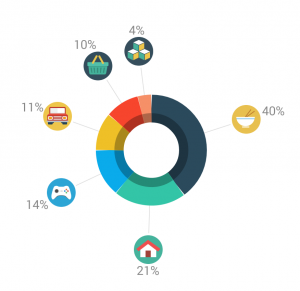
A cost breakdown for the month using our budgeting app.
If you’re trying to save cash and are settling down for a while, a monthly rental can be found here for about 9,000 baht if you’re willing to stay a few kilometers away from the main beach area. Doing this will save you cash and the restaurants and shops get cheaper as you move farther from the beach. A scooter rental will cost you 250 baht per day or only 3,000 baht per month. If you were to eat all three meals a day at restaurants, your daily food allowance would need to be between 350-500 baht per person. However, stocking up on groceries and eating breakfast and/or lunch at home can save some cash and drop your daily food costs down to 150-250 baht per day. Prices at restaurants can more than triple when you get to the main beach strip and the quality of food isn’t any better. Sometimes you have to give in and spend 200 baht on that piña colada so you can watch the sunset at a beachside bar.
Trips around Ao Nang are affordable if you do some searching. There’s no shortage of tour companies offering up the same tours and booking packages for every budget, but prices can vary wildly. Check a few offices before booking to find the best price. A typical trip in Ao Nang is the 4 Islands Tour which takes you on a longtail boat tour for almost eight hours, serves you lunch and drinks, picks you up and drops you off from your accommodation, and provides you the use of a mask and snorkel and an English-speaking guide. All this sets you back only 400 baht per person (in high season!) however, we did see it being advertised for about 800 baht per person as well. For divers, a two-dive day out to the Phi Phi Islands including equipment rental, lunch, and snacks will cost about 3,500 baht. They’re not the best prices in Thailand compared to dive meccas like Koh Tao, but Ao Nang does have some of the best diving.

Example day of spending in Thai baht.
Strangest Things:
On a songthaew taxi into town, we talked with a fellow passenger. He was Romanian, spoke Hungarian (one of the languages spoken at home for my husband growing up) and also had lived in Seattle, Washington near where I had grown up and gone to university. It’s not unusual to see expats living in Thailand and southern Thailand especially has its share. He reminded us how small the world can feel and how much in common each of us can have.
Typical Day:
We eat our cereal on the patio and watch our Thai neighbors go about their morning routines below. After doing some work on our computers, we make ourselves sandwiches for lunch and wrap up whatever we’ve been working on (articles, editing, video making). We pack a bag for the beach with our straw beach mat, towels, and books, then ride our scooter down to Ao Nang Beach. We set our mat up on the beach near the buoyed-off swimming area and alternate between sunbathing and swimming. Once the sun starts to set, we grab a couple of Singha beers from the 7-11 and share them in the sand while I shoot photos of the longtail boats with the pink sun glowing behind. After the sun is down, we drive to Jungle Kitchen for a delicious dinner of fruit shakes, spring rolls, and curries at a bamboo hut table. On our way home, we might stop at the local Tesco Lotus to pick up any supplies we may need for the next day: water, bread, peanut butter, etc.
Conversations with Locals:
Ao Nang attracts a lot of tourism, so of course there are many touts trying to get your business. As we walk down the street, we often get approached no fewer than ten times to have dinner at this restaurant, indulge in a massage, or, most interestingly, buy a custom-made suit. The other day, as we strolled down the main road, we saw a small frog sitting in the middle of the sidewalk. A restaurant tout noticed us observing the frog hop around and came over wordlessly and smiled at us. He stooped down and skillfully picked up the frog to show us. He didn’t say a word and we communicated with body language for a few minutes about the frog before it hopped away. We smiled and said our goodbyes and were never asked to eat at his restaurant or buy anything. Our interaction was totally a gesture of kindness and friendship and a marker of how genuinely kind Thai people are.
Where Next?
Now that we’ve been in Thailand for three months our visa and visa extension is running out. In February we’ll be flying to Siem Reap, Cambodia where we’ll be exploring Angkor Wat and later Phnom Penn. Follow our blog at Unknown Home for more on our travels!
Original article can be found here: Vagabonding Field Report: Ao Nang, Thailand
February 1, 2015
Travel, at its best, is braided together with life itself
“All I know is that I want to live somewhere I’ll have to relearn everything: how to cross the street, how to order coffee, how to deal with people whose modes of thinking are utterly, intriguingly foreign to my own. I want to be uncomfortable, to be an outsider not just in my own mind but in the eyes of everyone who glances at my awkward, bumbling self. I want to figure it out all over again, to savor the small good moments, and I want those tiny triumphs (and inevitable failures) to mark my days, and I want them to add up, over the years and the miles, to a far, far larger victory — that of experience, memory, and language over the unstoppable decay of time. To be clear: this is not wanderlust. Travel is not something separate from the rest of my life, something I need to “get back to.” For me, I’ve come to understand, travel and life are so intricately braided together that they cannot be teased apart.”
–Matt Gross, The Turk Who Loved Apples: And Other Tales of Losing My Way Around the World (2013)
(2013)
Original article can be found here: Travel, at its best, is braided together with life itself
January 31, 2015
Top 9 apps for offline maps
I’m on a deserted street in the middle of the night.
I’m somewhere outside of Rome, a couple blocks south (or north?) of a train station where I caught the last train in from the airport in an echoing station.
My hotel should be up here. Or maybe it was a couple blocks the other way. Or maybe I’m not even on the right street.
I squint in the blackness, trying to find street signs tacked on the sides of buildings. But no signs mark the small side streets. I walk down four more blocks to the large, blinding intersection and stand on a corner, frowning at the light poles, searching for a sign of where I am.
All I want to find is my hotel. All I want is to curl up in a soft bed and sleep away the remaining few hours of the night. All I want is a little blue blinking light of GPS to show me where I am and lead me to my hotel.
Here are the top nine apps for offline maps so you no longer have to wander in the night.
1. City Maps 2Go by Ulmon
(Apple App Store and Android Google Play, Free)
I used this app a lot. It saved me many times. City specific offline maps which you need to download for each city. But the map shows public transit information like stations, points of interest, and bookmark favorite places.

2. Galileo Offline Maps
(Apple App Store, $3.99)
This app can record GPS movements and store for later retrieval. It gives you detailed offline maps of entire countries, records your trips, bookmarks favorite spots so you can return to them (or track your path). Claimed to be smaller download size and faster than other offline maps.
3. Osmand.net
(Android Google Play, $5.99)
This app works totally offline. It gives you turn by turn guidance, highly detailed offline maps, bookmarks your favorite places, displays surrounding points of interest (my favorite). It also shows hiking and bike paths. And it’ll give you navigation for biking the crazy streets of Paris or walking in Venice’s alleys.
4. Pocket Earth
(Apple App Store, Free)
This app gives you detailed, small download size offline maps. Plus, you get public transit information and nearby points of interest.
5. Trip Advisor for specific city
(Apple App Store and Android Google Play, Free)
This app is my husband’s favorite when we travel. He’s in charge of navigation and likes how this offline map shows points of interest, bookmark favorite places, and shows thousands of user reviews for locations. It can be a little glitchy at times.
6. Map app on your smart phone
(Free)
I had no idea the GPS worked without my data enabled. But it does. And it saved me quite a lot. Sometimes the map doesn’t show up very detailed. But it helps to get a bird’s eye view on where you are and see if you’re really walking in the correct direction.
7. Maverick
(Google Play, Free)
This app has offline maps that are best for navigating the land in hiking or boating. You can bookmark favorite places and record tracks via GPS. The coolest part is you can check out your speed and altitude.

8. Maps.Me
(Apple App Store and Google Play, Free)
Offline, highly-detailed maps for all countries and cities. This app claims to never freeze while zooming. You can also do searching on the map, bookmark favorite places, and figure out where you are with GPS positioning.
9. Sygic
(Apple App Store and Android Google Play, starts at 39.99€ with a world map at 99.99€)
This is the premium offline map app. It calls itself the “world’s most downloaded offline navigation app.” This is the app you spring for when you’re feeling flush. It has offline maps for 100+ countries, free map updates, route planning, points of interest, and bookmarks. If you spring for the premium version, you get turn by turn navigation and voice guidance, with very handy warnings of upcoming speed limit changes.
Laura Lopuch blogs at Waiting To Be Read, where she riffs on reading, traveling, and gives you quotes to strengthen your soul.
Original article can be found here: Top 9 apps for offline maps
January 30, 2015
Explode your comfort zone…why the decision to travel is never a bad one
Growing up in Long Island, New York, my comfort zone was very small. I certainly never thought I’d leave that tiny suburban town for other coasts or other shores. After that first trip abroad everything changed. I had no idea then that harnessing fear of the unknown would be the thing that actually facilitated a growth spurt for my ever so tiny comfort zone. Little by little it started to grow and although, at times the fear tries to blur the lines, the desire of that comfort zone to stretch continues to win out. Almost twenty years after I graduated from a small university outside of Boston, I’m actively exploding that zone wide open and travel, for me, has been the blasting tool.
Even with strife and destruction happening daily in the world, I’ve yet to ever find a reason why the decision to travel could be a bad one. Day after day there’s sadness and devastation with people who aim to do evil striking at the heart of good. I’m not suggesting to directly put oneself in the line of fire or to go where those in the know say to heed, but travel will always open doors, help to defy stereotypes and change the world one traveler at a time.
Travel continues to provide endless gifts of perspective, growth, understanding and compassion. Comfort zones are great, but as we all know, minimal growth happens in them. Learning happens each time those boundaries are pushed and with even the slightest bit of movement, people are forever changed. Have you ever traveled by yourself and noticed those fears creeping in when what would be an adventure with a friend feels like disaster waiting to happen? Have you ever muttered the words ‘I’d never do this at home’ with a smile knowing that some sort of magic is about to happen even though you have no idea what, where or when? Have you ever found yourself wandering down a foreign land’s street filled with insane chaos, maddening sounds, bustling crowds, endless odors thinking just how different this is to your ‘normal Tuesday’ and how utterly amazing it is that you’re enjoying yourself as much as you are? We continue to surprise ourselves, if only we let ourselves.
Strange as it may sound – boundaries are pushed and comfort zones are meant to expand. As we grow, we learn of what we’re capable, what scares us and what, just maybe, we might want to push through. It’s the feeling of that little one finally letting go of a few fingers when she learns to cross the street or shouting, ‘let go, let go’ when he tries to take off on that first two-wheeler ride. Parents stand proudly by watching as that fine line swarms around them wondering, ‘do I run after him to keep hold or let him see what he can do on his own’. Now, we’re those grown up little ones guarding our choices and teetering on the edge of can I or can’t I, will I or won’t I and pushing ourselves to take that risk knowing that we’ll be alright whatever the outcome. Each leap really is one of leaps and bounds.
Travel has been the force propelling me forward. That desire to see the world, visit other destinations, meet new people, experience and wonder has frightened me, pushed me, amazed me and changed me. It gave me direction when I had little. It showed me paths that I would have never before taken. It introduced me to impactful people I wouldn’t have otherwise met. It showed me that different isn’t bad, difficult is worth the struggle and that change shouldn’t only scare me. I owe a debt to travel and the best way I know to repay it is to keep on going and thanking travel each day for helping me to explode that comfort zone.
Things I never thought I could…and did!
Live overseas
Jump into the edge of Victoria Falls
Travel solo
Go on an around the world honeymoon
Make my way through a language barrier
Walk with lions
Road trip across the USA
Quit my job to travel
How do you explode your comfort zone? How did a travel experience push your boundaries?
For more of Stacey’s travel musings, check out her blog.
Original article can be found here: Explode your comfort zone…why the decision to travel is never a bad one
January 29, 2015
Dealing with the Loneliness of Long-Term Travel
Every now and then long-term travel is rough.
The lifestyle of never remaining in one city or continent for more than a few months requires commitment and sacrifice.
Traveling alone means experiencing days and occasionally weeks without making friends and starting over in a new place can seem tedious.
When this happens, travelers often feel overwhelmed with homesickness, wishing for old friends and all the comforts of home.
Through my experience on the road, I have learned long-term travel requires determination, but the rewards and perks of this astounding lifestyle outweigh the battle of loneliness.
Let’s talk about a few ways to combat loneliness on the road.
Embrace Your Feelings
Loneliness is a good feeling. When it is creeping up on you, use it as a time for personal growth. With no one around, there is ample time to reflect on your adventures and how traveling has transformed you as a person.
Reflection is a tool to help us learn more about ourselves. Evaluate the lessons the road has taught and ponder where your path might lead.
Embrace your loneliness. Within a short period of time, you will feel renewed and excited for the journey ahead.
Stay Productive
Beginning a project is a vital way to keep loneliness from entering your mind. If you are journaling, video editing, or photo sorting; long hours in trains, buses, and airports become desirable.
For example, many times my travel blog, and other projects keeps me extremely busy. I often look forward to alone time so I can get caught up. I don’t even have a chance to get lonely.
Find something you are passionate, or start a travel job and pour yourself into it when you start to feel alone.
Improve Yourself
We live in the golden age of travel. With easy access to Ipads, laptops, and smart phones the world is easily accessible. New discoveries and knowledge are just clicks away.
When I started traveling, I promised myself every day I would try to improve as a person.
One goal was teach myself a new language. This not only took my mind off of being alone, but also gave me a better cultural understanding of the countries I was visiting.
Use loneliness for self-improvement and you will not only become a better person but a more responsible traveler.
Remember Your Goals
Having travel goals is one of the best ways to deal with loneliness on the road.
Goals help keep long-term travelers focused and are a continual reminder of why traveling is important.
Whether you want to see every country in the world or to just sip wine under the Eiffel Tower, goals keep your ship pointed north when it wants to go astray.
Talk to Strangers
This is going against everything you mother taught you since you were two years old, but one lesson the road teaches quickly is that 99% of people want to help.
If you are missing home or feeling alone, just start talking to someone in the area.
Chances are you will make a new friend which can ease loneliness.
I’ve seen loneliness break travelers and honestly, it has almost broken me a few times.
Knowing how to deal with loneliness is vital for any long-term traveler.
While the feeling is not always pleasant, it can be a gift to learn more about yourself, break out of your shell, and grow as a person.
Stephen is a long-term traveler and loneliness defeater. You can check out more of his musing of life on the road at his website A Backpackers Tale, Facebook, and Instagram.
Original article can be found here: Dealing with the Loneliness of Long-Term Travel
January 28, 2015
How young is too young to travel?
How young is too young to travel? It’s a question that comes up whenever the subject of family travel arises. Some worry about the risk of illness for infants on the road. Others have fears that their child will reject every food option that isn’t chicken fingers and starve. Concerns about water, weather, and boredom keep lots of families from traveling with young kids. Of all the reasons, the reason most often cited as the reason for not traveling with young kids is, “they won’t even remember.” Are these concerns, any of them, justified?
In my experience, not really.
There are precautions for illness and medical care all over the world, no child will starve themselves because chicken fingers are not on the menu, and boredom is, in my opinion, an essential element to the development of any human being. But the big reason, the one about the kids not remembering, is the one that I think deserves the most attention. After all, traveling with kids is hard, right? And babies won’t remember it anyway, right?
Wrong.
Can traveling with children be challenging? Yes. Are there moments that are harder than others when traveling? Yes. But the answer to both of those question is no different than if I were to ask the same questions of a family at home. There are so many things parents do on a daily basis that are “hard”, but no one shies away from them because their kid may not remember. We recognize, as the more experienced beings, that sooner or later, children will internalize our consistent messages- even the ones we didn’t intend!
An infant may not remember seeing the Taj Mahal and a four year old may forget the name of the kid he played ball with for hours in Bali. However, it is also possible that they won’t remember making cookies with Grandma for the holidays, snuggling with the family dog for naps, breastfeeding, or learning to read. Would you deny any of those experiences to your child because they might not remember? Of course not. We recognize the benefits of these experiences, whether or not our kids carry forth conscious memories of those moments. Travel is no different.
I realize it is scary to plop down a whole bunch of money on an experience your kid may or may not be able to recall. But babies “remember” things in all kinds of ways. Even if your baby won’t consciously remember all of the kind people who fawned over her in Thailand, she may have internalized, without you even realizing, that love transcends language barriers and that people with skin different than hers are not to be feared. That’s powerful stuff. More powerful than being able to recite the places you visited to aunts and uncles.
We do lots of things with our babies that they won’t consciously remember. We sing to them, read to them, play with them, smile at them, and talk to them. We don’t do these things so that they can make a collage of it one day to share with their class. We do these things because it lays the groundwork for what we want our babies to internalize as they grow- kindness, love, and connection.
Traveling with little kids is never a bad idea. Before you know it, babies become children and children become teenagers who are moving towards their own, independent life. Wait until it’s “easier” and “they’re old enough to remember” and you might miss your opportunity. Traveling early begins the intentional creation of family culture- culture built around an active involvement in life and a joy of exploring.
Besides, even if your kid “doesn’t remember” the way adults do, you know who will? You. You will forever remember watching your baby take her first steps at a Mayan temple, hearing your two-year-old sing along in Hindi to a new favorite song, and watching your four-year-old climb atop a surf board for the first time in Costa Rica. You will remember what your daughter looks like with sand all over her face and what your son looks like as he combs the beach at sunset.
There is no such thing as “too young to travel” so, what’s stopping you?
Original article can be found here: How young is too young to travel?
January 26, 2015
Should terrorism keep Americans from traveling overseas?
In the wake of recent terror attacks in Paris and an article in an Al Qaeda magazine that provided instructions for making a bomb that is undetectable by current airport security technology, the U.S. State Department issued the following travel warning for Americans traveling abroad:
“Recent terrorist attacks…serve as a reminder that U.S. citizens need to maintain a high level of vigilance and take appropriate steps to increase their security awareness”
On face value, the alert might seem a normal precaution, however a week later the Department of Homeland Security said,
“there is no specific, credible threat of an attack on the U.S. like what happened in Paris last week”
A Google search for the two statements is telling. The State Department warning was found on 2,510 websites, many of which were major media outlets, while the latter statement by Homeland Security showed up on 15 sites, only one of which was a major media outlet (ABC-TV). Little wonder that Americans are mired in fear over the prospect of international travel.

Google search for State Department travel warning
The reticence of Americans to travel overseas is a well documented fact. A consumer study by Skift.com – a leading source of news, information, data and services for the travel industry – concluded that only 13 percent of Americans traveled internationally in 2014. This is hardly surprising, given State Department statistics that less than 38 percent of the U.S. citizens hold a passport. Though this figure is slightly misleading (legal residents of the U.S. who are not citizens and hold foreign passports are not counted in the State Department numbers), it is still significantly below the percentage of passport holders in other countries. Contrast it with the 83% of non-immigrant British citizens who hold passports.
According to the U.S. Department of Commerce Office of Travel and Tourism Industries, the actual figures are even worse than the Skift study indicates. Only 29,015,463 Americans (9 percent) traveled to international destinations in 2013 – the most recent year for which statistics are available – and this includes destinations in Mexico and the Caribbean, which have long been vacation havens for U.S. travelers.
American reluctance to travel abroad may have been born from our isolationist viewpoint during the Revolution, when we not-so-politely informed England we no longer needed or wanted them. Not only is isolationism in our DNA, the United States is so vast and diverse that most Americans feel no need to travel outside its borders. Exacerbating this is the fact that, unlike Europeans, whose holidays range from four to six weeks, the typical American worker receives one or two weeks of vacation. Considering that traveling offshore would take up two full days of an already short holiday, it makes perfect sense that Americans prefer to vacation in their own backyard.
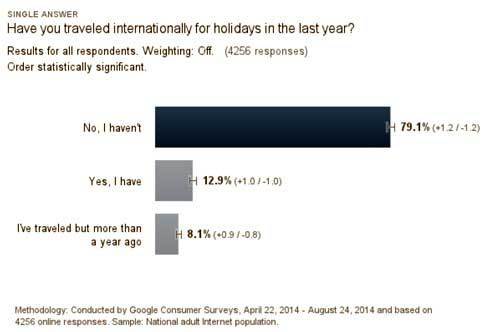
2014 survey by Skift.com – travel habits of Americans
The lack of exposure to cultures other than their own, however, carries a price that may not be realized for generations. Last week I struck up a conversation with two 20-something women working at a Chicagoland coffee shop. Neither of them had ever traveled outside the U.S. or had any interest in traveling internationally.
Both agreed they hated to fly, but admitted this had nothing to do with fear of airplanes. Their displeasure revolved around the endless security lines and ever-changing rules of the TSA. “We had to go to a family event in Florida a few months ago,” one of them recounted, “and we decided to drive because it was so much easier.”
“I’m just uncomfortable being around people who don’t speak English,” the other said. “And my husband is a police officer, so he is very concerned about safety. It’s a pretty scary world these days. Have you ever had problems when you travel?”
I recounted that in all my years of travel, I’ve only had one bad experience; many years ago, I was robbed while staying in a campground on the Hawaiian island of Kauai. Not only have I never felt unsafe or threatened in any of the 50+ foreign countries I’ve visited, it would take me hours to recount all the kindnesses that people around the world have shown me. Locals have invited me into their homes, shared meals, and closed their shops to help me find my way in unfamiliar locales.
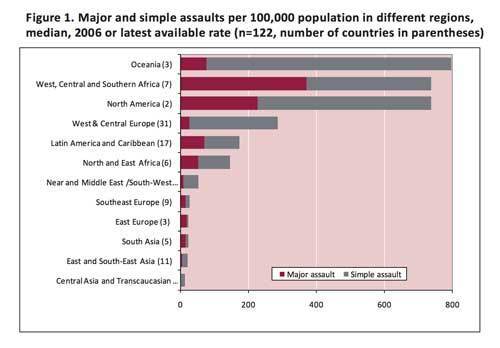
Combined figures for major and minor assaults by world region, per the European Institute for Crime Prevention, In affiliation with the United Nations
Sadly, most Americans gauge the safety of the world by reports on CNN and Fox, which spew fear mongering news around-the-clock, and recent coverage of the terrorist attacks has only amplified our fears. As a result, we stay home, where we feel safe. Yet are we truly safer, or is this an illusion? The European Institute for Crime Prevention and Control, in affiliation with the United Nations, ranks North America as having the third highest incidence of assaults per 100,000 population, after Oceania and parts of Africa. We are far more likely to be involved in a mugging close to home than one in in a foreign country.
Do we need to be vigilant when we travel? Of course. It is advisable to leave your jewelry at home, avoid flashing large amounts of money, limit your intake of alcohol, abstain from illegal drug use, and stay away from politically motivated demonstrations. Above all, travelers should practice being aware of what is happening around them at all times. But terrorist attacks are no excuse to stay home. If we do, we become ever more insulated from the world and fearful of other cultures. If we do, the terrorists win.
When Barbara Weibel realized she felt like the proverbial “hole in the donut” – solid on the outside but empty on the inside, she walked away from corporate life and set out to see the world. Read first-hand accounts of the places she visits and the people she meets at Hole in the Donut Cultural Travels. Follow her on Facebook or Twitter (@holeinthedonut).
Original article can be found here: Should terrorism keep Americans from traveling overseas?
Rolf Potts's Blog
- Rolf Potts's profile
- 323 followers











